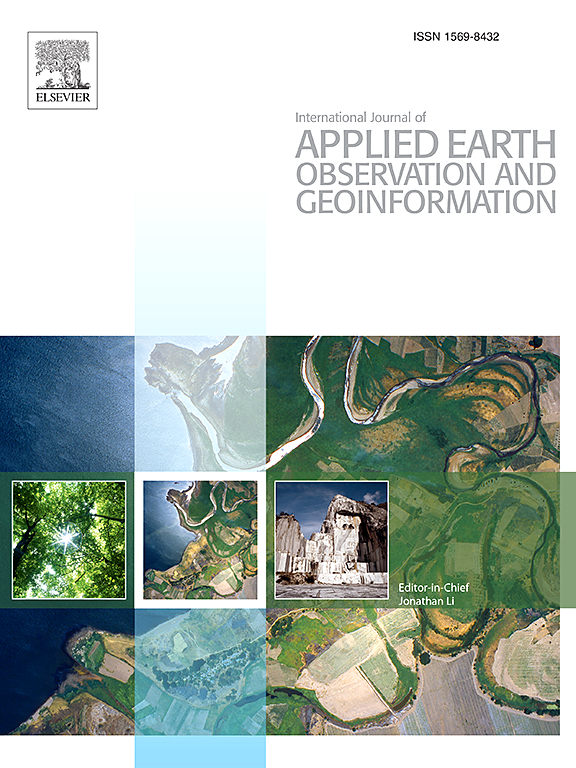露天煤矿排土场恢复后植被恢复的时空动态及关键气候影响
IF 8.6
Q1 REMOTE SENSING
International journal of applied earth observation and geoinformation : ITC journal
Pub Date : 2025-06-04
DOI:10.1016/j.jag.2025.104646
引用次数: 0
摘要
植被恢复力是了解区域生态系统自我修复和适应能力的关键。露天煤矿排土场是典型的生态修复对象,恢复后的植被生态系统极不稳定,容易发生状态转移。然而,现有的研究在植被恢复特征及其气候驱动机制方面存在局限性。本研究以平庄西露天煤矿排土场为研究对象,利用临界减速(CSD)理论和2008 - 2024年Landsat长期遥感数据,解决了这些不足。我们提出了“MultiRes”,一种像素级(30米)的方法来计算植被恢复力。与传统的固定窗口方法不同,MultiRes提供了具有广泛稳定性的自适应窗口大小。分析了恢复后植被恢复力的时空动态,评价了植被恢复效果,定量评估了不同阶段关键气候驱动因素的影响。结果表明:①恢复后,各排土场植被恢复能力经历了初始增强、下降和再增强三个阶段;(2)与初始脆弱生态系统相比,植被恢复能力显著提高,超过88%的面积得到改善,其中太平地植被恢复能力增强率达到99.85%。(3)各排土场各阶段主要气候驱动因子的影响保持一致,尤其是第一阶段和第三阶段。受单一气候驱动因素影响的地区通常比受多种气候驱动因素影响的地区表现出更显著的变化。这些发现表明,植被恢复能力捕获了NDVI无法单独检测到的特定阶段的生态模式,从而支持了采矿环境中的适应性恢复和气候知情管理。本文章由计算机程序翻译,如有差异,请以英文原文为准。

Spatiotemporal dynamics and key climatic influences on vegetation resilience in opencast coal mine dumps after restoration
Vegetation resilience is crucial for understanding the self-repair and adaptive capacity of regional ecosystems. Opencast coal mine dumps, typical targets for ecological restoration, exhibit highly unstable vegetation ecosystems after restoration, making them prone to state shifts. However, existing studies have limitations in capturing vegetation resilience characteristics and its climatic driving mechanisms. This study addresses these deficiencies by focusing on the Pingzhuang West Opencast Coal Mine dumps, utilizing Critical Slowing Down (CSD) theory and long-term Landsat remote sensing data from 2008 to 2024. We propose ’MultiRes’, a pixel-level (30 m) method to calculate vegetation resilience. Unlike traditional fixed-window approaches, MultiRes offers adaptive window sizes with a wide range of stability. We analyzed the spatiotemporal dynamics of vegetation resilience after restoration, evaluated the effectiveness of vegetation restoration, and quantitatively assessed the impact of key climatic drivers across different phases. Results reveal that: (1) After restoration, vegetation resilience at each dump experienced three phases: initial enhancement, decline, and renewed enhancement. (2) Vegetation resilience improved significantly compared to the initial fragile ecosystem, with over 88 % of the area showing improvement, especially at Taipingdi, where the enhancement rate reached 99.85 %. (3) The influence of key climatic drivers remained consistent within each dump across all phases, particularly in the first and third phases. Areas dominated by a single climatic driver generally showed more significant changes than those influenced by combined drivers. These findings demonstrate that vegetation resilience captures stage-specific ecological patterns that NDVI alone cannot detect, thereby supporting adaptive restoration and climate-informed management in mining environments.
求助全文
通过发布文献求助,成功后即可免费获取论文全文。
去求助
来源期刊

International journal of applied earth observation and geoinformation : ITC journal
Global and Planetary Change, Management, Monitoring, Policy and Law, Earth-Surface Processes, Computers in Earth Sciences
CiteScore
12.00
自引率
0.00%
发文量
0
审稿时长
77 days
期刊介绍:
The International Journal of Applied Earth Observation and Geoinformation publishes original papers that utilize earth observation data for natural resource and environmental inventory and management. These data primarily originate from remote sensing platforms, including satellites and aircraft, supplemented by surface and subsurface measurements. Addressing natural resources such as forests, agricultural land, soils, and water, as well as environmental concerns like biodiversity, land degradation, and hazards, the journal explores conceptual and data-driven approaches. It covers geoinformation themes like capturing, databasing, visualization, interpretation, data quality, and spatial uncertainty.
 求助内容:
求助内容: 应助结果提醒方式:
应助结果提醒方式:


